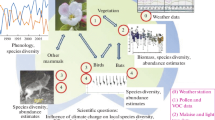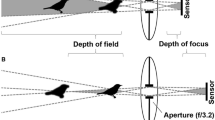Abstract
Remote photography using various photo, movie or video devices has been employed in numerous studies in wildlife research during the last 50 years. Given the rapid advances in digital technologies, digital video and photo techniques are becoming more common in use, and publications that introduce a new method or equipment for video surveillance in wildlife research (and in ornithological studies particularly) are appearing almost every year. However, still no special guide to the great variety of equipment and methods is available, and the choice and use of suitable gear for scientific purposes may be difficult for non-specialists. In this paper, we review the most common surveillance techniques used in today’s nest studies, as well as the most essential properties of image recording equipment. We also describe the digital video recording technique, which we used for observations of raptor nests, and summarise our experience of its operation. As an example of the obtained data, we present the timing of prey deliveries of goshawks and common buzzards.



Similar content being viewed by others
References
Booms TL, Fuller MR (2003) Time-lapse video system used to study nesting gyrfalcons. J Field Ornithol 74:416–422
Cain SL (1985) Nesting activity time budgets of bald eagles in southeast Alaska. M.S. thesis, University of Montana, Missoula, MT
Cutler TL, Swann DE (1999) Using remote photography in wildlife ecology: a review. Wildl Soc Bull 27:571–581
Delaney DK, Grubb TG, Garcelon DK (1998) An infrared video camera system for monitoring diurnal and nocturnal raptors. J Raptor Res 32:290–296
Dykstra CR, Meyer MW, Warnke DK (2002) Bald eagle reproductive performance following video camera placement. J Raptor Res 36:136–139
Fargallo JA, Laaksonen T, Korpimäki E, Poeyri V, Griffith SC, Valkama J (2003) Size-mediated dominance and begging behaviour in Eurasian kestrel broods. Evol Ecol Res 5:549–558
Franzreb KE, Hanula JL (1995) Evaluation of photographic devices to determine nestling diet of the endangered red-cockaded woodpecker. J Field Ornithol 66:253–259
Fyfe RW, Olendorff RR (1976) Minimizing the dangers of nesting studies to raptors and other sensitive species. Can Wildl Serv Occas Pap 23:1–16
Grønnesby S, Nygård T (2000) Using time-lapse video monitoring to study prey selection by breeding Goshawks Accipiter gentilis in Central Norway. Ornis Fenn 77:117–129
Häkkinen I (1977) Food catch of the Osprey Pandion haliaetus during the breeding season. Ornis Fenn 54:166–169
Hubert C, Le Pape G, Gallo A (1994) Analysis of the nestling feeding behaviour in the female common buzzard. Etología (Madr) 4:47–56
King DI, DeGraaf RM, Champlin PJ, Champlin TB (2001) A new method for wireless video monitoring of bird nests. Wildl Soc Bull 29:349–353
Kleintjes PK, Dahlsten DL (1992) A comparison of three techniques for analyzing the arthropod diet of plain titmouse and chestnut-backed chickadee nestlings. J Field Ornithol 63:276–285
Korpimäki E (1981) On the ecology and biology of Tengmalm’s Owl (Aegolius funereus) in southern Ostrobothnia and Suomenselkä, western Finland. Acta Univ Ouluensis A Sci Rerum Nat 118:1–84
Kristan DM, Golightly RTJ, Tomkiewicz SMJ (1996) A solar-powered transmitting video camera for monitoring raptor nest. Wildl Soc Bull 24:284–290
Lewis SB, DeSimone P, Titus K, Fuller MR (2004a) A video surveillance system for monitoring raptor nests in a temperate rainforest environment. Northwest Sci 78:70–74
Lewis SB, Fuller MR, Titus K (2004b) A comparison of 3 methods for assessing raptor diet during the breeding season. Wildl Soc Bull 32:373–385
Liebezeit JR, George TL (2003) Comparison of mechanically egg-triggered cameras and time-lapse video cameras in identifying predators at dusky flycatcher nests. J Field Ornithol 74:261–269
McQuillen HL, Brewer LW (2000) Methodological considerations for monitoring wild bird nests using video technology. J Field Ornithol 71:167–172
Nilsson P, Ekenstedt J (2005) Rapport från ett kunsörnbo. Kungsörnssymposium. [Proceedings of the Golden Eagle symposium in Alnön, Sundsvall, Sweden.] Länsstyrelsen i Västernorrland. P. 37 (in Swedish)
Rogers AS, DeStefano S, Ingraldi MF (2005) Quantifying northern goshawk diets using remote cameras and observations from blinds. J Raptor Res 39:303–309
Rosenberg KV, Cooper RJ (1990) Approaches to avian diet analysis. Stud Avian Biol 13:80–90
Rytkonen S, Koivula K, Orell M (1996) Patterns of per-brood and per-offspring provisioning efforts in the willow tit Parus montanus. J Avian Biol 27:21–30
Smithers BL, Boal CW, Andersen DE (2005) Northern goshawk diet in Minnesota: an analysis using video recording systems. J Raptor Res 39:264–273
Stake MM, Cimprich DA (2003) Using video to monitor predation at black-capped vireo nests. Condor 105:348–357
Temple SA (1972) A portable time-lapse camera for recording wildlife activity. J Wildl Manage 36:944–947
Warnke DK, Andersen DE, Dykstra CR, Meyer MW, Karasov WH (2002) Provisioning rates and time budgets of adult and nestling bald eagles at inland Wisconsin nests. J Raptor Res 36:121–127
Wiehn J, Ilmonen P, Korpimäki E, Pahkala M, Wiebe KL (2000) Hatching asynchrony in the Eurasian kestrel Falco tinnunculus: an experimental test of the brood reduction hypothesis. J Anim Ecol 69:85–95
Wille F, Kampp K (1983) Food of the white-tailed eagle Haliaeetus albicilla in Greenland. Holarct Ecol 6:81–88
Acknowledgements
We are grateful to Jari Ylönen, Juhani Itämies, the Experimental Zoo and the Zoological Museum of the University of Oulu for support in funds and equipment. Matti Rauman was our guru and rescuer in all technical issues. Matti Suopajärvi kindly accommodated our caravan and informed us of the location of most of the buzzard nests. We also thank Kalevi Tunturi, Pentti Hukkanen and Mikko Viitanen for assistance and for providing us with nest coordinates, Patrik Byholm for help with the literature data, Vladimir Tumanov for improving the language of the manuscript and Erkki Korpimäki for valuable comments. The Foundation of the Finnish Association for Nature Conservation (Suomen Luonnonsuojelun Säätiö), Ella and Georg Ehrnrooth Foundation and the Environmental Graduate School EnviroNet of the University of Oulu provided the financial support at various stages of the study (to VR). The methods used in this study comply with the current laws of Finland.
Author information
Authors and Affiliations
Corresponding author
Rights and permissions
About this article
Cite this article
Reif, V., Tornberg, R. Using time-lapse digital video recording for a nesting study of birds of prey. Eur J Wildl Res 52, 251–258 (2006). https://doi.org/10.1007/s10344-006-0039-1
Received:
Accepted:
Published:
Issue Date:
DOI: https://doi.org/10.1007/s10344-006-0039-1




